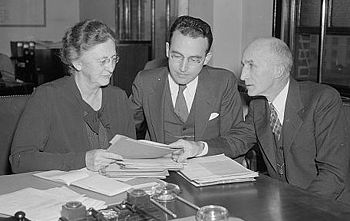Arthur J. Altmeyer
Arthur J. Altmeyer (1891-1972) was a key figure in the design and implementation of the U. S. Social Security system.

He was born in Wisconsin and developed an early interest in social security while working as an office boy in his uncle's law office.[1] He attended the University of Wisconsin-Madison where he studied with John R. Commons, one of a handful of American economists versed in social insurance who was actively interested in workers' compensation, unemployment insurance and health insurance. In 1918, Altmeyer became Commons' research assistant. Together they co-authored a report on "The Health Insurance Movement in the United States" for the Illinois Health Insurance Commission and the Ohio Health and Old Age Insurance Commission.[2] In 1931, Altmeyer earned a Ph.D. in Economics from the University of Wisconsin.
Altmeyer became Chief Statistician of the Wisconsin Industrial Commission in 1920, and founded a monthly publication, the Wisconsin Labor Market, which was second such publications in the U.S. In 1922, he was appointed Secretary of the Wisconsin Industrial Commission, a position he held, with one interim, until 1932. In 1927 he went on leave to assume a temporary federal position in the Great Lakes Region with responsibility for implementing the Longshoremen's and Harbor Workers' Compensation Act.[3]
In Spring, 1933, he was invited to Washington by Labor Secretary Frances Perkins to consult on relations with state labor departments, and in November, 1933, he was appointed Director of the Labor Compliance Division of the National Industrial Recovery Administration. He returned briefly to Madison again in May, 1934 and almost immediately was appointed Assistant Secretary of Labor.[4]
In June, 1934, Altmeyer, acting upon instructions from President Franklin Delano Roosevelt, Secretary Perkins and Presidential Adviser Harry Hopkins, drafted for the president Executive Order 6757, which provided for creation of a Committee on Economic Security; the committee which oversaw drafting of the bill which became the Social Security Act of 1935. Perkins chaired the committee, which included Altmeyer, Hopkins, as well as Secretary of the Treasury Henry Morgenthau Jr., Attorney General Homer Cummings, and Secretary of Agriculture Henry A. Wallace. The Committee selected as its Executive Director Edwin E. Witte of the Economics Department at the University of Wisconsin and an expert in labor legislation.[5]
Altmeyer remained in Washington from 1934-1953. In that period, he was involved in implementation of the Civil Service merit system (1939); survivor's insurance (1939); variable federal grants based on state per capita income (1939-1946); disability insurance (1939-1953). [6]
References
- ↑ Arthur J. Altmeyer, The Formative Years of Social Security (Madison: University of Wisconsin Press, Year Needed), vii.
- ↑ Altmeyer (1968), p. viii
- ↑ Altmeyer (1968), viii.
- ↑ Altmeyer (1968), ix
- ↑ ibid, p. 7.
- ↑ Jean K. Quam, "Altmeyer, Arthur J. (1891-1972)," Encyclopedia of Social Work. 19th Edition. Vol. 3. Washington DC: NASW Press. p. 2572.)